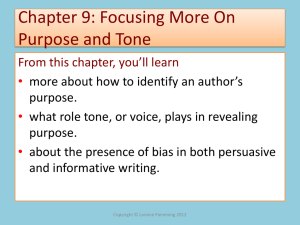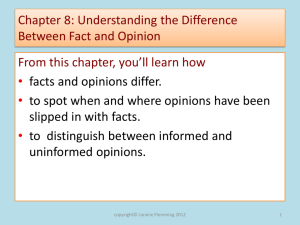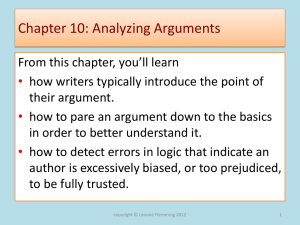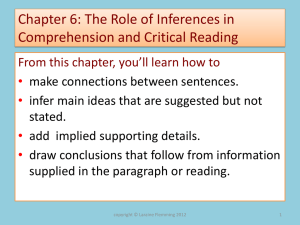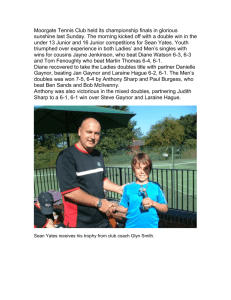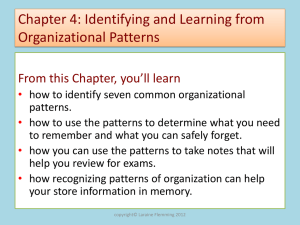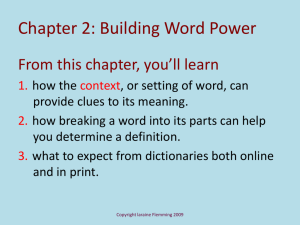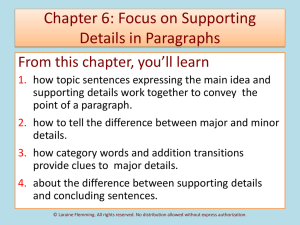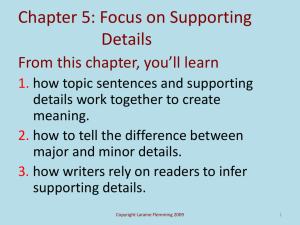RfR_Ch 11-Purpose, Tone, and Bias
advertisement
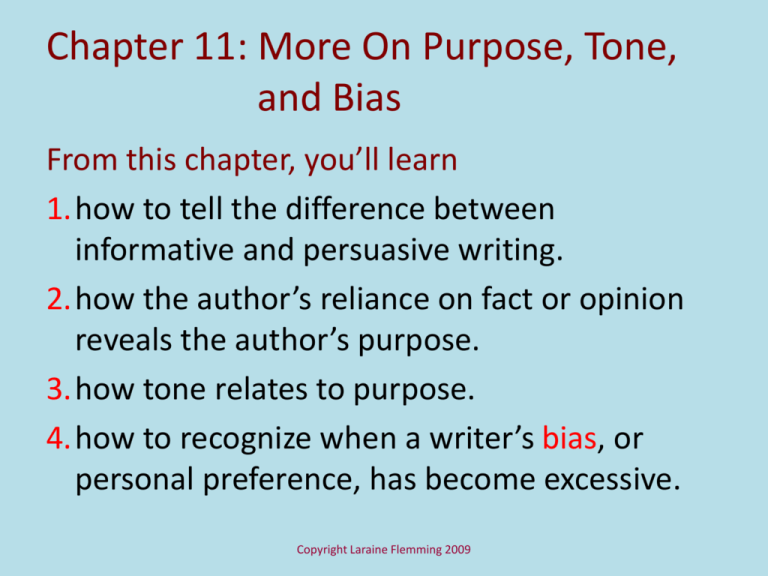
Chapter 11: More On Purpose, Tone, and Bias From this chapter, you’ll learn 1.how to tell the difference between informative and persuasive writing. 2.how the author’s reliance on fact or opinion reveals the author’s purpose. 3.how tone relates to purpose. 4.how to recognize when a writer’s bias, or personal preference, has become excessive. Copyright Laraine Flemming 2009 11.1 Defining Terms The Two Basic Purposes of Writing: • to inform: When the writer’s purpose is informative, the writer tries to explain an issue or describe a topic without evaluating it or trying to tell readers how they should feel about the subject under discussion. • to persuade: When the writer’s purpose is persuasive, the intent is to convince readers to share or at least strongly consider a particular point of view. Copyright Laraine Flemming 2009 Just so You Know There’s a third purpose not addressed either here or in your text, it’s aesthetic, or artistic, appreciation. Addressing that purpose would take an entire book, maybe two, to discuss it in ways that aren’t trivial or silly. Still, it seems important to mention that in classes where you read, say, poetry or short stories, you are encountering material that doesn’t quite fit into either of the categories described here or in your text. Really good artists aren’t all that interested in dispensing information or sharing opinions. Their goal is to make you participate in the world more intensely. When works of art are successful, they help you feel and experience worlds other than your own. Copyright Laraine Flemming 2009 11.1 Defining Terms Informative writing has the following characteristics. It • makes no attempt to convince readers to share a specific opinion or take a specific action. • describes or explains the ideas of others without evaluating them. “John Dewey’s theory of education was based on the belief that children learn by doing.” • suggests that the opinions expressed belong to people other than the author. “According to science writer Gina Kolata, ‘The Hawthorne Effect,’ much written about in psychology and business texts, is based on very little sound evidence.” • expresses both sides of an argument with equal effectiveness. Copyright Laraine Flemming 2009 Informative Writing (continued) • relies on language that has little or no emotional impact on readers. • appears mainly in reference works, newspaper articles, journals, and educational web sites. • relies heavily on factual statements and avoids colorful imagery. • includes no references to the author’s personal feelings. • avoids appealing to the audience’s emotions. Copyright Laraine Flemming 2009 11. 1 Example of Informative Writing Sleep researcher Robert Stickgold says that rapid-eye movement, or REM, sleep is essential to memory consolidation. In other words, it is during REM that new information is analyzed, categorized, and stored in long-term memory. In support of his theory, Stickgold cites numerous studies in which researchers teach subjects a new task and then break the subjects into two different groups: (1) subjects who get tested later the same day and (2) subjects who get re-tested after a night’s sleep. Based on his research, Stickgold maintains that subjects who sleep after learning consistently perform better than those who got no sleep. Copyright Laraine Flemming 2009 11. 1 Defining Terms Persuasive writing has the following characteristics. It • attempts to convince readers to share or at least consider a specific point of view. • often announces that something should be understood, done, or evaluated in a certain way. “We need to promote Internet literacy in our schools”; “Urban renewal has been a massive failure.” • expresses competing points of view while pointing out that one opinion or perspective is better than another. • explicitly or implicitly reveals the author’s bias, or personal leanings. • usually employs emotionally charged language. Copyright Laraine Flemming 2009 Writing to Persuade (continued) • appears in editorials, reviews, books that are not reference works—such as encyclopedias and dictionaries—and web sites promoting a theory or person. • makes use of strong imagery designed to sway emotions. “Muzzle the trumpets, still the drums. The market for reason is slipping fast. The currency of ignorance and demagoguery* is daily gathering strength.” • often includes personal pronouns that refer to the author and/or the audience. “We cannot allow the teaching of literature to be abandoned in favor of job training.” *demagoguery: the use of speech to appeal to prejudice and uncontrolled emotion. Copyright Laraine Flemming 2009 11.1 Example of Persuasive Writing The highly-regarded sleep researcher Robert Stickgold has solved the mystery of rapid-eye movement, or REM, sleep, which has long been a puzzle. REM has been a mystery because the brain waves recorded by electroencephalographs during this stage of the sleep cycle suggest a highly active state of mind, similar to the state of being awake. Stickgold, however, has solved the mystery, and his research shows that during REM, new learning is analyzed, categorized, and stored in memory. In other words, it’s during REM sleep that memory consolidation takes place. While Stickgold’s theory still has its critics, the majority of those engaged in sleep research believe he has figured out why brain activity during REM sleep is so intense: It’s because the sleeping brain is busy working on consolidating the news of the day. Copyright Laraine Flemming 2009 A Word to the Wise The two purposes can intermingle, but one is almost always primary, or more important, than the other. For instance, to convince you that the global warming is a reality, not a myth, a writer might start an essay with a straightforward list of facts about changes in temperature, sea level, plant, and animal life. That information is there mainly to introduce the writer’s point, which is persuasive: “We must begin to reduce energy consumption or the damage to Earth and its inhabitants will only grow worse.” In this case, the primary purpose is persuasive, and the informative writing just paves the way for the author’s attempts to convince. Copyright Laraine Flemming 2009 1.1 Recognizing the Primary Purpose When thinking about the primary purpose, keep in mind that 1. the purpose sometimes changes as the reading develops. 2. a persuasive piece of writing can open with a purely informative introduction but then move steadily in the direction of persuasion. 3. if informative writing turns persuasive, the author’s overall intent is usually persuasion, not a balance of the two. 4. it’s far less likely for a writer to open with a persuasive passage and then become strictly informative. 5. when it comes to identifying the primary purpose, how the author ends up is more important than how he or she begins. Copyright Laraine Flemming 2009 11.1 Now that you’ve seen examples of both informative and persuasive writing, what’s the author’s purpose in this paragraph? Many people with a product to sell seem to think that creating a web site would be good for business. However, what they don’t seem to realize is that not just any web site will do. Anyone looking to sell products on the web needs to meet the needs of online consumers. Those who buy online, for instance, are impatient. If the pages on a site take more than a second or two to download, consumers are likely to leave without buying. Similarly, online shoppers of all ages are not fond of small print or excessively busy pages. Too many bells and whistles on a site, accompanied by tiny print, and the seller can forget about increasing sales via the Internet, no matter how good the available product actually is. Copyright Laraine Flemming 2009 11.1 And the purpose here is? At 11:30 p.m. on December 6, 1982, Charles Brooks, the first convicted murderer to be executed through lethal injection lay down on a hospital gurney. His body was secured by five leather straps, and at 11:35 medical technicians inserted two intravenous needles, one in each arm. A saline solution began flowing into Brooks’s bloodstream, and that harmless solution was quickly followed by a mix of three chemicals, all of them fatal to the human body. Brooks died within ten to thirty seconds from an overdose of barbiturates. The other two drugs, which caused a fatal muscle paralysis and cardiac arrest, were a form of insurance. If the lethal dose of barbiturates didn’t kill Brooks, one or both of the other drugs would ensure his death. Copyright Laraine Flemming 2009 A Word to the Wise The more you are aware of a writer’s purpose, the more attuned you will be to writers who end up conveying their personal prejudices despite the neutral context of their work, e.g., textbooks and references works and their own stated or implied intention to supply you with facts minus any value judgments. You’ll also be primed to identify writers who want so badly to persuade their readers, they end up producing careless arguments, which rely more on emotional intensity or careless reasoning than they do on logic. Copyright Laraine Flemming 2009 11.2 Determining Purpose by Looking at Facts and Opinions Recognizing the balance between fact and opinion in a piece of writing can help you determine an author’s purpose. However, that means you need to clearly understand the difference between fact and option. Which of the following statements, then, is a fact and which one is an opinion? 1. On August 17, 1896, forty-four-year-old Bridget Driscoll became the first woman to be killed by a car; the car was traveling four miles per hour and the impact proved fatal. 2. The traffic death of forty-four-year-old Bridget Driscoll in August of 1896 was the first sign that the auto, hailed as an industrial triumph, was to become a weapon of mass destruction. Copyright Laraine Flemming 2009 11.2 Fact Versus Opinion The first statement is a fact, the second an opinion. Now the key question is this: Why is the first statement a fact and the second an opinion, given that the two statements share similar information? Copyright Laraine Flemming 2009 11.2 Comparing Facts and Opinions Statement 1 is a fact because it can be verified, or proven true, by any of the following sources: records, witness statements, reference books, and photos. Statement 2 is an opinion because not everyone in the world would see that first traffic accident as a sign of the auto’s destructive power. That’s a personal interpretation, or understanding, of how that incident might be viewed. Ask other people if they agree, and the answers will vary from person to person. Facts do not vary with their source. Copyright Laraine Flemming 2009 11.2 Defining Terms Factual statements • are likely to use dates, numbers, and statistics. • are not affected by the person who reports them. • identify and describe events in language that has little or no emotional effect on the listener or reader. • don’t make predictions, express value judgments, or offer interpretations. • can be verified, or checked, for accuracy. • aren’t subject to change unless previously unavailable information or new technology arrives on the scene. Copyright Laraine Flemming 2009 11.2 Defining Terms Statements of opinion • often use language that packs an emotional punch. • reflect a personal interpretation or point of view. • often make value judgments, e.g., “Jimmy Carter was a better president than most people think.” • frequently predict future events, e.g. “We are going to regret our failure to address the problem of homelessness.” • often provide interpretations, e.g., “Tupac Shakur could not escape his violent past.” • cannot be checked for accuracy. • are reflections of what the speaker or writer has learned and experienced. Copyright Laraine Flemming 2009 11.2 From Fact to Opinion The following statement is a fact: “In 2008 Beyoncé Knowles played the blues singer Etta James. How might you change it into an opinion? Copyright Laraine Flemming 2009 11.2 From Fact to Opinion Here’s one possibility: “Beyoncé Knowles rose to the occasion when she played blues legend Etta James in the movie Cadillac Records.” Rephrased in this way, the statement now offers a value judgment. Beyoncé excelled in playing the part of blues singer Etta James, whom the author considers a “legend.” Copyright Laraine Flemming 2009 11.2 From Opinion to Fact The following statement is an opinion: “Lance Armstrong had no business trying to make a comeback in the 2009 Tour de France bicycle race.” Can you transform that opinion into a statement of fact? Copyright Laraine Flemming 2009 11.2 From Opinion to Fact Here’s one possibility: “In 2008, Lance Armstrong announced, he was coming out of retirement in order to participate in the next Tour de France.” Now the statement excludes any interpretation, prediction, or value judgment. Everything stated can be verified in some way. Copyright Laraine Flemming 2009 A Word to the Wise A heavy emphasis on facts along with a cool, neutral tone are a dead giveaway to the writer’s informative purpose. Similarly revealing are the use of a passionate tone to express personal opinions. The two together are marks of a persuasive purpose, which makes attending to a writer’s tone particularly important to critical reading. Copyright Laraine Flemming 2009 11.3 Defining Terms: A Writer’s Tone Like the tone of a person’s voice, tone, or voice, in writing refers to the attitude, emotion, or feeling about the subject matter that a writer conveys to the reader. Although non-fiction writers often become identified with a particular tone, they can shift the tone or voice of their writing to suit the context or subject matter. Here are a few of many possibilities: • furious • sympathetic • neutral • comical • bullying • solemn • curious • cautious • mistrustful • confident Copyright Laraine Flemming 2009 11.3 How Writers Choose a Tone Writers choose a tone based on • their personal feelings about a subject. • purpose, i.e., informative or persuasive. • context , e.g., for a reference book or a weekly magazine, a newspaper front page, or an inside editorial. • personal preference: some writers vary their tones; others are more comfortable assuming a comic or a serious tone. • the audience. Copyright Laraine Flemming 2009 A Word to the Wise The factors that go into choosing or assuming a tone can vary with the circumstances. A writer who pens a letter protesting a bad review may not bother to control her angry tone. However, if she is assigned to write an entry for, say, a dictionary of global culture, she is not going to let anger play a role in the tone of the entry. Her tone will be more controlled and neutral. The context requires the change in tone. Copyright Laraine Flemming 2009 11.3 Writers Vary Their Tone Based on a Number of Different Factors What tone do you hear in the following snippet from Calvin Trillin’s collection of food essays called “Alice, Let’s Eat.” • “If a research team systematically interviewed serious shellfish eaters about their most memorable shellfish experience, I suspect that the unifying theme would be messiness. Ask anyone who truly loves shellfish about the best he ever had, and the answer tends to be a story ending with the table being hosed down after the meal or mountains of shells being shoveled into trash bins. It is apparent to serious shellfish eaters that in the great evolutionary scheme of things, crustaceans developed shells to protect them from knives and forks.” Copyright Laraine Flemming 2009 11.3 What tone do you hear in the following excerpt from Trillin’s memoir about the loss of his wife, Alice, who died in 2001? • “…she would have been right in saying that the people whose exposure to her had been through my stories didn't know her. Still, in the weeks after she died I was touched by their letters. They may not have known her, but they knew how I felt about her. It surprised me that they had managed to divine that from reading stories that were essentially sitcoms. Even after I'd taken in most episodes of The Honeymooners… it had never occurred to me to ponder the feelings Ralph Kramden must have had for Alice Kramden. Yet I got a lot of letters like the one from a young woman in New York who wrote that she sometimes looked at her boyfriend and thought, "But will he love me like Calvin loves Alice?" Copyright Laraine Flemming 2009 11.3 How Does a Writer Create a Tone? All of the following can play a role in making readers hear a feeling or an attitude in the writer’s words: • word choice • imagery • sentence and paragraph length • grammar, i.e., formal or conversational • references to the audience or self • selection of details Copyright Laraine Flemming 2009 Just so you Know Writers spend an extraordinary amount of time thinking about how they sound on the page. They worry about how they are presenting themselves to their readers. The Dominican American writer Junot Díaz, for instance, has said somewhat regretfully “…my personality tends to be blunt, straightforward, outspoken. My written personality is nowhere near as dynamic.” Writer Anna Quindlen has suggested that speech therapy for stuttering may have helped her find her voice as a writer,“ I don’t know whether I developed the written voice and then imitated it, once I had speech therapy, or vice versa. But in any case, I know that I have a distinctive voice on the page, and that it’s intimately related to my actual voice.” Copyright Laraine Flemming 2009 11.3 Tone and Readers Readers need to pay attention to tone because • it helps reveal the writer’s purpose. • it helps them better understand the effect of tone on their response. • it offers a solid clue to the writer’s degree of bias, i.e., the more emotional the tone, the greater the bias. • it will make them better readers, more aware of the many different ingredients that go into an effective piece of writing. Copyright Laraine Flemming 2009 11.4 The Role of Bias in Informative and Persuasive Writing The more passionate the tone the more likely it is that the author harbors a bias for or against the subject or issue under discussion. In persuasive writing, • bias is to be expected. • bias is only bad if the writer goes overboard and insults or won’t even acknowledge an opposing point of view. In informative writing, • authorial bias is supposed to be almost completely eliminated. Copyright Laraine Flemming 2009 11.4 What’s the author’s purpose and can you detect a bias? What’s a Mining Hall of Fame without Miners? The National Mining Hall of Fame and Museum, first opened in 1988, cries out to be included in any discussion of how history can be distorted. The Mining Museum doesn’t say much about those who have done the actual mining in the United States; the luminaries* it does showcase are mainly white Anglo-Saxon Protestant men, most of them mine owners, executives, or engineers rather than, god forbid, actual miners, who risked their life to dig metals from the earth. In reality, mining has been one of America’s most multicultural occupations with, among others, Italians mining granite in Vermont, Finns digging for copper in Michigan, and Chinese Americans panning for gold in the West, but you’d never know that from visiting the National Mining Hall of Fame. * luminaries: famous people, stars Copyright Laraine Flemming 2009 11.4 What’s the author’s purpose and can you detect a bias? 1. 2. 3. 4. 5. The signs for a persuasive purpose and a strong bias are certainly there: The language sometimes packs an emotional punch, for instance, the mining museum is an example of history being “distorted,” or misrepresented. This opinion, for that’s what it is, is not attributed to someone else. The author takes full responsibility for it. The tone with its sarcasm—”rather than, god forbid, actual miners”—makes it clear that the author has strong feelings on the subject. So, yes, there is a bias. The selection of detail highlights the contrast between what’s displayed in the museum as the history of mining and the reality of mining across the country. Above all, there’s no hint of an opposing point of view. Copyright Laraine Flemming 2009 11.4 The Experienced Reader’s Response to Bias Now that you know the purpose and can detect a strong bias, the question is, Is the writer’s bias so strong readers need to learn more before sharing the opinion expressed? Copyright Laraine Flemming 2009 11.4 What about this next passage drawn from an encyclopedia of famous spies? What’s the author’s purpose and can you detect a bias? Although no state historical marker tells us about her, visitors who step inside Bellevue elementary school in Richmond, Virginia can learn about Elizabeth Van Lew, the woman Donald E. Markle, author of Spies and Spymasters of the Civil War, called “one of the great female spies of all time.” Born in 1818, Van Lew had been introduced to the fight against slavery when, as a child, her family sent her to a Quaker school in Philadelphia. When the American Civil War began in 1860, Van Lew had no doubts about which side she was on and she was determined to do everything she could to further the Union cause of abolition. To that end, she developed a spy ring consisting of about a dozen wealthy citizens who shared her Unionist sympathies. Setting up a series of check points on route to Union headquarters at Hampton Roads, Virginia, Van Lew sent messages to General Grant’s forces. Like that other tactical genius, Sojourner Truth, who freed countless slaves by guiding them through the underground railroad, Van Lew knew how to cover her tracks: She let her hair grow wild and took to mumbling to herself when she was out in public, so that those who might have suspected her of siding with the enemy considered her crazy rather than dangerous. Van Lew’s actions in service to the Union were never discovered. After the war ended, she managed to get her war records from the federal government so no one could know the extent of her activities. But somehow her neighbors found out, and Van Lew was shunned by most of the community for the rest of her life. Copyright Laraine Flemming 2009 11.4 What about this passage? Can you identify the purpose and do you detect a bias? At least where laundry is concerned, going green is causing friction between those who favor hanging laundry on a clothesline to save both energy and money and those who feel the sight of someone else’s “unmentionables” blowing in the wind is distasteful. Some states are already taking sides. Florida, Utah, Maine, Vermont, Colorado, and Hawaii have passed laws restricting housing associations from creating legislation or rules that might stop a person from pegging clothes on a clothes line. The legislation in other states, however, doesn’t help people like Kevin Firth of Pennsylvania. Firth, who lives in a condominium, was fined $100 for hanging his laundry up outside. And Firth is not alone, so much so that a group called “Product Laundry List” has formed around one core issue—the right to hang laundry out-of-doors. Members of the group are determined to fight the housing associations they think are denying them a basic American right. Carl Weiner, a lawyer for a number of homeowners associations, says that the “no-laundry outside” attitude of his clients may change in time as people become more aware of how much energy clothes dryers consume: Dryers account for about 6 percent of residential electricity use. But for now, their attitude is “Keep your unmentionables in your own home. We do not want to see them.” Copyright Laraine Flemming 2009 Finishing Up: More on Purpose, Tone and Bias2 You’ve previewed the major concepts and skills introduced in Chapter 11. Take this quick quiz to test your mastery of those skills and concepts, and you are ready to read the chapter. Copyright Laraine Flemming 2009 Finishing Up: More on Purpose, Tone, and Bias 1. What’s the primary purpose of the following reading? Dwight D. (Ike) Eisenhower, the 34th President of the United States, was born in Denison, Texas in 1890. He was the first professional soldier elected to office since Ulysses S. Grant and the first president to preside over 50 states. Eisenhower’s public image was that of a conservative thinker, who believed deeply in the rights of the states to govern themselves. But the real “Ike” was a good deal more devious and less conservative than the public knew. People were profoundly shocked when Eisenhower called in the national guard to protect black students trying to enter an all-white high school in Little Rock, Arkansas. Conservatives didn’t interfere with states rights. Eisenhower, however, was never a conservative. As he himself expressed it in a 1951 letter kept secret for years, he had always had “liberal sympathies.” He just kept them hidden. Copyright Laraine Flemming 2009 Finishing Up: More on Purpose, Tone, and Bias Although the paragraph initially seems to serve an informative purpose, the primary pattern is persuasive because 1. the author directly expresses a personal opinion, e.g., Ike was not what he seemed. 2. some of the language is emotionally charged, e.g., uses the word “devious.” 3. no opposing point of view is expressed. 4. the opinion expressed is the author’s; it’s not attributed to someone else. Copyright Laraine Flemming 2009 Finishing Up: More on Purpose, Tone, and Bias 2. How would you label the following sentences, fact or opinion? a. Dwight D. (Ike) Eisenhower, the 34th President of the United States, was born in Denison, Texas in 1890. b. He was the first professional soldier elected to office since Ulysses S. Grant and the first president to preside over 50 states. Copyright Laraine Flemming 2009 Finishing Up: More on Purpose, Tone and Bias 3. How would you label these two statements, fact or opinion? a. Eisenhower, however, was never a conservative. b. As he himself expressed it in a 1951 letter he kept hidden for years, he had always had “liberal sympathies.” Copyright Laraine Flemming 2009 Finishing Up: More on Purpose, Tone and Bias 4. What tone do you hear in the following passage from Jessica Valenti’s blog “Feministing”? Is her tone a. enthusiastic? b. critical? c. astonished? d. horrified? Copyright Laraine Flemming 2009 Finishing Up: More on Purpose, Tone and Bias • “As I grew up and began identifying myself as a feminist, there were plenty of issues that continued to make me question marriage: the father "giving" the bride away, women taking their husband's last name, the white dress, the vows promising to "obey" the groom. And that only covers the wedding. Once you get married, women are still implicitly expected to do the majority of the housework and take care of any future children. I remember reading one study that said that even couples who had been living together for years in equitable* bliss ended up with a more "traditional" division of household labor if they got married—as though signing that piece of paper somehow skewed their sense of fair play.” *equitable: equal Copyright Laraine Flemming 2009 Finishing Up: More on Purpose, Tone, and Bias 5. Does the author of the following reading express a bias in favor of or against the prime minister of Russia? Russian prime minister Vladimir Putin is a mysterious figure. He has been accused of many things, among them ordering the murder of journalists who oppose him. But is the fear and mistrust of Putin deserved or merited? It’s hard to say. Putin is most frequently accused of tearing up the Russian constitution and destroying civil rights. Yet if that is true, how does one explain that Putin won two presidential elections, 2000 and 2004, with impressive margins? And despite descriptions to the contrary, Putin has a light side. He’s a music lover, with a passion for Russian folk songs. Plus he can carry a tune. He’s even been known to turn up at hip hop events, claiming that hip hop promotes a “healthy life style.” Copyright Laraine Flemming 2009 Brain Teaser Challenge Copyright Laraine Flemming 2009 Brain Teaser Challenge The Greek philosopher Aristotle said that “Character may almost be called the most effective means of persuasion.” How might a writer, with the intention to persuade, make practical use of that information? Do you think Aristotle is correct? Whether your answer is yes or not, please explain it as persuasively as possible. Copyright Laraine Flemming 2009
